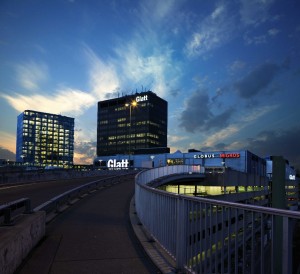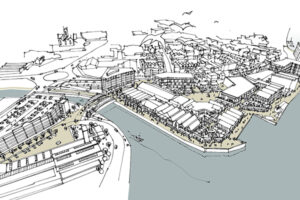In 2014, Swiss shopping centers increased their turnover, albeit only slightly, by 0.5%. That’s about the same growth as in the previous year, 2013 (+0.4%). This growth is put into perspective, however, when one notes that the retail area increased by 1.6% in 2014 and by 1.5% in 2013.
The productivity of Swiss shopping centers therefore also declined in 2014, namely by 1.1% to CHF 6,326.00/sq m (€5,749/sq m). This was as part of a total turnover of CHF 16.53 million on an area of 2.613 million sq m, which is about the area of 360 soccer fields. The revenue share of Swiss shopping centers is about 17% of the total market.
Varied sales development
On closer examination, it is obvious that the above turnover trend has not applied equally to all centers. 27% of all the centers recorded sales growth of more than 1% over the previous year, 36% were able to maintain their sales levels, and 37% suffered a decline in sales. If one compares the sales development to the size of the shopping center, it becomes evident that centers with more than 40,000 sq m of retail space were able to maintain their sales and productivity compared to last year, but they also had to accept a slight decrease in sales and productivity of approximately 2% in each of the last 4 years. Centers with retail space of 20,000-40,000 sq m lost just under 3% of their sales and 4.2% of their productivity in the same period (2010 to 2014), while centers with under 20,000 sq m lost around 2.5% of both their sales and productivity.

The five train stations with the largest retail areas (Basel, Bern, Geneva, Lucerne, and Zurich) enjoyed around CHF 1.028 billion in sales on 43,667 sq m of retail space in 2014. In comparison, the highest-selling center in Switzerland, the Glattzentrum in Wallisellen, had about CHF 619 million in sales on about the same area.
As before, the retail spaces in the large train stations are among the most productive in the country. On average, this productivity lay around CHF 23,433/sq m. The absolute leader in terms of productivity is the railway station in Bern. It generates annual sales of around CHF 32,469/sq m. Zurich Airport’s turnover was not quite as high, but it still enjoyed a slight increase of 0.8% on its approximately 31,820 sq m of retail space (land and airside). At approximately CHF 17,000/sq m, the productivity of its airport shopping lies behind that of the large train stations but is still much higher than that of traditional shopping centers.
The largest outlet center in Switzerland, Fox Town in Mendrisio, maintained its turnover in 2014.The center’s visitors, mostly tourists, spend around CHF 350 million in the luxury boutiques on around 30,000 sq m of retail space near the Italian border.
The year 2015
According to the present sales figures for 2015, it seems that the sales growth in Swiss centers enjoyed in previous years has stalled. According to recent studies, Swiss centers lost between 2% and 5% in 2015. Both classic retailers and shopping centers in Switzerland are currently experiencing difficult times due to sometimes heavy losses in turnover. There are a number of events and reasons that have not only slowed the usual growth, but have ensured sometimes massive declines and losses. The industry is increasingly aware that habitual thinking and behavior patterns are no longer valid and that the rules are being redefined by new avenues like e-commerce and multi-channeling and also by society’s changing consumer behavior.
An industry in transition
Due to the high density and intensity of competition and the current economic conditions, many Swiss shopping centers find themselves in a period of dramatic change. For decades, the industry could rely on the proven “consumer temple” model, wherein the focus was on long-term leases and functional and efficiency-driven selling machines.
Revitalization and refurbishment
Switzerland is currently home to 189 shopping centers, with the oldest already over 40 years old. The average age among all centers is around 28 years and a large portion of them have never been extensively remodeled or revitalized. It therefore can and must be assumed that a wave of revitalizations will wash over Switzerland in the next few years. First, these objects must be refurbished because of their outdated building materials while the technical and operational systems are renewed or replaced. Second, due to the changing market situation, the centers must be repositioned, taking into account not only their profiles, but also their space and usage concepts, including tenant mix, which have to be re-defined and adjusted. The revitalization or refurbishment of shopping centers is one of the most current and relevant topics for the shopping center industry worldwide and is commonly and appropriately referred to as the “supreme discipline” of commercial real estate management.
Outlook

Shopping centers are currently developing themselves ever more into “leisure and entertainment destinations.” They are places where people not only shop, but also spend their free time, enjoy entertainment, and want to experience something. In other words: They’re becoming all-around leisure experiences with possibilities for shopping. Correspondingly, the usage and tenant mix is changing towards “mixed use”: retail, catering, services, leisure, and entertainment. Simultaneously, the bricks-and-mortar trade is facing a process of change when it comes to what tasks and role stationary stores will have in the future. Put another way: Why would a retailer or brand need retail space in the future and what would happen in those spaces? This process of change presents many shopping center owners and operators with great challenges and calls for new ideas, vision, and strategies. The industry can thus expect new and innovative solutions in this regard.





